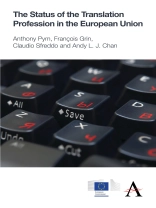Based on thorough and extensive research, this book examines in detail traditional status signals in the translation profession. It provides case studies of eight European and non-European countries, with further chapters on sociological and economic modelling, and goes on to identify a number of policy options and make recommendations on rectifying problem areas.
There are strong indications that traditional mechanisms of signalling the status of translators are no longer functioning as they should, and that new online mechanisms are turning status into a readily available commodity. Despite demonstrating that some of the traditional status signals do still function relatively well, the book nevertheless finds that others appear to be failing for various reasons, and that this has resulted in a degree of market disorder. Such circumstances may cause good translators to leave the market, which is clearly an undesirable situation for all concerned.
The work was written by a team of eminent scholars in the field, with contributions from a host of other academics and professional translators, and includes five appendices providing very useful information on areas of specific interest.
İçerik tablosu
GENERAL INTRODUCTION; 1. METHODOLOGICAL ISSUES 1.1. What Do We Mean by Status? 1.2. What Do We Mean by “Signalling” and “Asymmetric Information”? 1.3. What Do We Mean by “Certification”, “Accreditation”, and “Authorisation”? 1.4. Data-Gathering Methodology; 2. RESULTS 2.1. What is the Status of Translators in Official Categorisations? 2.2. What is the Relative Status of Educational Qualifications and Training? 2.3. The Status of Translators of Official Documents 2.4. The Role of Translator Associations; 3. CASE STUDIES 3.1. Germany 3.2. Romania 3.3. Slovenia 3.4. United Kingdom 3.5. Spain 3.6. United States 3.7. Canada 3.8. Australia; 4. SOCIOLOGICAL MODELLING 4.1. Models of Professionalisation 4.2. The Changing Role of Translator Associations 4.3. A Majority of Women – So What? 4.4. A Profession of Part-Timers and Freelancers? 4.5. The Role of Employer Groups 4.6. Comparison between Translators and Computer Engineers as Emerging Professions; 5. ECONOMIC MODELLING 5.1. Information on Rates of Pay 5.2. Estimations of Earning Equations 5.3. Asymmetric Information, Signalling, and Equilibrium on the Market for Translations; 6. POLICY OPTIONS FOR ENHANCED SIGNALLING 6.1. Free Market or Controlled Entry? 6.2. One Signal or Many? 6.3. Signalling as a Commodity or a Service? 6.4. Modes of Possible Intervention; 7. Recommendations; APPENDIX A. Translator Associations: Years of Foundation and Numbers of Members; APPENDIX B. Why There Are About 333, 000 Professional Translators and Interpreters in the World; APPENDIX C. Online Translator–Client Contact Services: New Modes of Signalling Status; APPENDIX D. Types and Use of Economic Perspectives on Translation; APPENDIX E. Equilibrium on the Translation Market; NOTES; REFERENCES; ACKNOWLEDGEMENTS; NOTES ON THE RESEARCH TEAM
Yazar hakkında
‘Anthony Pym is professor of translation and intercultural studies and coordinator of the Intercultural Studies Group at the Rovira i Virgili University in Tarragona, Spain.
François Grin is professor of economics at the Faculty of Translation and Interpreting of the University of Geneva.
Claudio Sfreddo has a Ph D in political economy and a diploma in economics and finance from the University of Geneva, as well as a bachelor’s in business management from the University of Lausanne.
Andy L. J. Chan has a Ph D in translation and intercultural studies from the Rovira i Virgili University in Tarragona, Spain as well as a master’s in economics from the University of Virginia, USA. ‘












